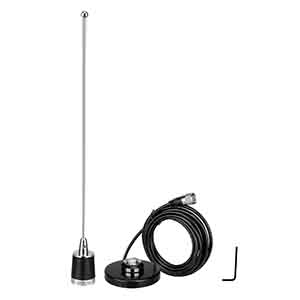Magnetic antenna

Magnetic antenna
What is a magnetic antenna?
A magnetic antenna base, also known as a mag-mount, or magnetic mount is a type of antenna mount that uses magnetism to attach itself securely to a metal surface. The attachment is non-permanent making it a flexible mounting solution for a range of applications.
Talk About Magnetic Field Antennas
The magnetic loop antenna measures the magnetic field (H-field) emanating from the EUT. Measurement of the H-field is often specified when RE testing below the normal 30 MHz lower frequency point is required by the product standard. The typical frequency specification for a magnetic loop antenna is 9 kHz to 30 MHz. Magnetic loop antennas are specifically designed to measure H-fields and ignore the influence of the E-field element present within electromagnetic signals.
Product standards that require RE testing below 30 MHz and use of the magnetic loop antenna include CISPR 15 for lighting equipment and FCC Part 18 for Industrial, Scientific, and Medical Equipment (ISM). Others include CISPR 11, CISPR 13, CISPR 14, and CISPR 32. Those standards which describe construction and proper use of magnetic loop antennas include the likes of MIL-STD-461G, ANSI C63.4 and EN 55015-1-1 (a.k.a. CISPR 16-1-1).
With any EMC emissions test standard, repeatability from one test event to another, or even one test site to another, is a major concern. RF emission H-field measurements taken below 30 MHz are in the near-field region. In this RF region, the consequences of reflections, room resonances and other metallic structure proximity effects take over and predominate when utilizing typical E-field test measurement antennas. These detrimental effects are lessened when using a magnetic loop antenna and test repeatability is improved.
In addition to improved test repeatability when testing below 30 MHz, use of the magnetic loop antenna has other advantages over that of traditional RE test antennas. These include simplicity of use and ruggedness. The loop of the magnetic loop antenna is simply constructed out of a coil of wires. Based on Faraday’s law, when a magnetic field passes through the loop of wires, the coil generates a voltage at its terminals related to its RF frequency. The operation of the magnetic loop antenna doesn’t get any simpler than this, and because the loop antenna is simply constructed out of a coil of wires, it is relatively easy to make them immune to the everyday bumps and bruises encountered in a typical EMC test facility environment.
Besides using magnetic loop antennas for compliance tests in strict accordance with standards, they can be used for engineering design and pre-compliance work. A shielded loop antenna probe can easily be constructed in-house. By making the loop physically small, and by orientating the plane of the loop 90° to the field to be measured, localized fields in close proximity to RF noise sources such as enclosures, seams, apertures, cables, components, and printed circuit board traces may be easily detected. For instance, high RF leakage around the seams or apertures of an enclosure indicate a faulty joint or too high of a shield transfer impedance. By knowing where the RF noisy areas are, the designer is better prepared in developing a quieter solution that will meet full-compliance RF emission standards. The beauty is that all of this information can be obtained easily and quickly in a quiet area of your office or lab, without even having to use a complicated and expensive full-compliance test setup.
It’s not all good though. There are some disadvantages with the use of magnetic loop antennas in conducting RE measurements. The instruments used to measure the voltages from the terminals of the loop antenna typically have a 50Ω input impedance. The loops of wire found in the loop antenna can have a much lower impedance depending on the frequency being measured. A mismatch can occur between the loop antenna and measurement device, resulting in inaccurate measurement readings. Some passive loop antennas allow for the manual selection of a different number of coiled windings which provide the correct impedance over specific bandwidths of frequency. This has a further disadvantage of not allowing for test automation as manual intervention is required.
Other types of loop antennas are considered “active” and contain a low-impedance preamplifier (preamp*) in the front-end. The preamp flattens out the loop’s frequency response and matches its output to that of the 50Ω input to the measurement instrument. One disadvantage in the use of preamps is that they can become saturated if large signals are present. Standards such as ANSI C63.4 require some form of overload indication. Another disadvantage with the active loop antennas is that the preamp requires some form of power. If preamp power is via battery, then it is wise to make sure it’s amp-hour rating supplies a runtime that is long enough to meet individual testing needs and/or a second antenna is available as backup in case the first one runs out of power.
If you want to buy the Magnetic antenna, you can check the retevis magnetic antenna.
Retevis magnetic-mount antennas, and magnetic bases for antennas, have a direct ground: RF chassis ground through the antenna magnetic base.
MR200 U/V Dual Band NGP Antenna and NMO Mount

Impact Resistance: Other antennas are long and prone to snap or break on impact with environmental elements/overhangs. Sinclair's 20.25 inch SW-2340(X)-(Y) design uses extremely rugged housing material and a shock spring for prolonged flexibility and durability in the field.
Ruggedness: retevis magnetic antenna is robust and built for Public Safety and emergency response vehicles of any type and in any environment.
Design: retevis magnetic antenna is rugged and offers a sleek design in either a silver or black finish to give vehicle fleets the range needed to communicate consistently.
NMO interface: an NMO mount for easy installation on all vehicles.






